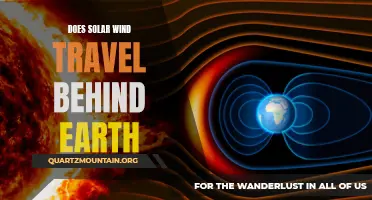
The mysterious depths of outer space have captivated the human imagination for centuries. From gazing at the stars on a clear night to dreaming of interstellar travel, humanity has long been fascinated with the cosmos. But what if we could actually explore the vast expanse of space, journeying to another solar system? In this article, we will delve into the possibilities of interstellar travel and the technologies that could one day allow us to embark on a journey through the cosmos. Get ready to go on an intergalactic adventure as we delve into the possibilities of exploring the cosmos.
| Characteristics | Values |
|---|---|
| Distance to the Target System | Varies depending on the target system |
| Spacecraft Speed | Very high (close to the speed of light) |
| Duration of the Journey | Decades to centuries |
| Energy Source | Nuclear fusion |
| Required Technology | Advanced propulsion systems and sustainable life support systems |
| Survival Challenges | Long-term exposure to space radiation, microgravity, and isolation |
| Destination | A habitable exoplanet or star system |
| Communication during the Journey | Limited and delayed |
| Navigation and Course correction | Advanced navigation and precision maneuvering systems |
| Payload Limit | Limited by the spacecraft technology and propulsion capabilities |
| Interstellar Hazards | Interstellar dust and space debris |
| Crew and Population | Small crew or potentially a generational ship for a larger population |
| Cost of the Mission | Extremely high and requires global collaboration |
| Social and Psychological Impact | Significant impact due to isolation and long-term space travel |
What You'll Learn

The Challenges of Interstellar Travel
Interstellar travel, or the ability to travel between stars in different solar systems, is a concept that has fascinated humanity for centuries. The idea of exploring distant worlds, meeting extraterrestrial life forms, or even colonizing new planets has captured the imaginations of scientists, writers, and dreamers alike.
However, despite our best efforts and technological advancements, interstellar travel remains an enormous challenge. The vast distances between star systems, the limitations of our current propulsion systems, and the hazards of space travel all present significant obstacles that need to be overcome.
One of the primary challenges of interstellar travel is the immense distances involved. Even the nearest star system to ours, Alpha Centauri, is approximately 4.37 light-years away. To put this into perspective, light, traveling at a speed of about 300,000 kilometers per second, would take over four years to reach our nearest neighbor. This means that any voyage to another star system would likely take decades or even centuries to complete, making it impractical with our current technology.
Another challenge is the limitations of our current propulsion systems. While our rockets are capable of propelling spacecraft into space and even sending probes to other planets within our own solar system, they simply do not have the power or efficiency required for interstellar travel. The energy and resources needed to propel a spacecraft for such long distances are currently beyond our capabilities. Novel propulsion systems, such as nuclear propulsion or antimatter drives, are still largely theoretical and would require significant advancements to become a reality.
In addition to these technological challenges, interstellar travel also presents numerous hazards to human beings. The long periods of time spent in space expose astronauts to cosmic radiation, which can have detrimental effects on their health. Moreover, the isolation and confinement during such a journey can lead to psychological and physiological issues, as seen in the challenges faced by astronauts on long-duration missions like those to the International Space Station.
Despite these challenges, scientists and researchers are actively pursuing solutions to make interstellar travel a reality. Concepts such as fusion propulsion, which harnesses the power of nuclear fusion to generate thrust, hold promise for achieving higher speeds and more efficient propulsion systems. Breakthroughs in materials science and spacecraft design may also help protect astronauts from the dangers of cosmic radiation and mitigate the physical and psychological effects of long-duration space travel.
While we may not see interstellar travel become a reality in our lifetimes, the pursuit of this extraordinary goal pushes the boundaries of our knowledge and sparks the imagination of future generations. Solving the challenges of interstellar travel will not only expand our understanding of the universe but also open up vast possibilities for the future of humanity. So, as we face these challenges head-on, let us keep dreaming and striving for the day when we can embark on an interstellar journey to explore the wonders of the cosmos.
Understanding the Visa Requirements for Traveling to Lusaka: What You Need to Know
You may want to see also

Possible Technologies for Interstellar Travel
Traveling to another solar system is an exciting prospect that has captivated the imaginations of scientists, thinkers, and science fiction enthusiasts for decades. While we have made significant advancements in space exploration, reaching another star system poses unique challenges. However, several possible technologies have been suggested that could potentially pave the way for interstellar travel. In this blog post, we will explore some of these technologies.
Warp Drive:
Made famous by shows such as Star Trek, the concept of warp drive involves manipulating space-time to travel faster than the speed of light. According to theoretical physicist Miguel Alcubierre, a warp drive could be created by compressing space in front of a spacecraft and expanding space behind it, essentially creating a bubble that moves faster than light. While this idea is purely theoretical at this stage, it shows the potential for overcoming the vast distances between star systems.
Wormholes:
Wormholes are hypothetical tunnels that connect different parts of space-time. They are envisioned as shortcuts that allow for the rapid transportation of objects across vast distances. Scientists such as Kip Thorne have explored the possibility of creating and traversing wormholes, but significant challenges remain. These include finding a way to stabilize the wormhole and determining how to control its location and destination.
Nuclear Propulsion:
Nuclear propulsion is another technology that could potentially enable interstellar travel. The idea involves harnessing the immense energy released by nuclear reactions to propel a spacecraft. One proposed concept is the nuclear pulse propulsion, which uses small nuclear explosions to generate thrust. Other variations, like the nuclear saltwater rocket, involve using a nuclear reactor to heat a liquid propellant and expel it at high velocities. Although the technology is still in its early stages and has safety concerns, nuclear propulsion could significantly increase the speed and efficiency of spacecraft.
Light Sails:
Light sails utilize the momentum of photons from a directed laser beam or the sun to propel a spacecraft. By deploying a massive sail, the spacecraft can harness the force of solar radiation or a directed laser to accelerate and achieve high speeds. The concept has gained traction in recent years, with the successful deployment of small light sail spacecraft such as the Planetary Society's LightSail 2 mission. While current light sail technology is limited to relatively low speeds, advancements in materials, laser technology, and spacecraft design could make light sails a viable option for interstellar travel in the future.
Generation Ships:
In a generation ship scenario, humans would embark on a spacecraft designed to sustain multiple generations during the journey to another solar system. These ships would be self-contained ecosystems, providing everything necessary for long-duration travel. The idea is to create a sustainable environment that can support human life until arrival at the destination star system. While this approach does not involve new propulsion technologies, it presents an alternative method for interstellar travel.
While each of these technologies offers unique possibilities for interstellar travel, it's important to note that we are still far from achieving this feat. Overcoming the immense distances and logistical challenges of such a journey will require significant advancements in science, engineering, and our understanding of the universe. However, with continued exploration and innovation, these technologies could one day make interstellar travel a reality and open up a new frontier for human exploration.
Is a Visa Required to Travel to Guam?
You may want to see also

Potential Star Systems for Interstellar Exploration
Exploring the possibility of interstellar travel has long fascinated scientists and space enthusiasts alike. While our current technology is not yet capable of reaching another solar system, there are several potential star systems that hold promise for future exploration. In this blog post, we will discuss some of these star systems and what makes them attractive candidates for interstellar exploration.
- Alpha Centauri: Alpha Centauri is the closest star system to our own, making it an obvious choice for interstellar exploration. This system is actually a triple star system, consisting of three stars: Alpha Centauri A, Alpha Centauri B, and Proxima Centauri. Proxima Centauri, in particular, has received a lot of attention as it is the closest known star to our Sun. There have been ongoing efforts to develop spacecraft capable of reaching this star system, such as the Breakthrough Starshot project.
- Tau Ceti: Tau Ceti is another star system that has attracted interest for interstellar exploration. It is located relatively close to our solar system, at a distance of 11.9 light-years. Tau Ceti is similar to our Sun in terms of size and temperature, making it a potential home to Earth-like planets. The existence of five potential exoplanets in this star system further adds to its allure. However, the habitability of these planets is still a subject of debate and requires further investigation.
- Vega: Vega is a bright star located 25 light-years away from our solar system. It is one of the most well-known stars in the night sky and has captured the imagination of astronomers for centuries. Vega is twice as massive as our Sun and much younger, which makes it an interesting target for interstellar exploration. Its proximity and prominent visibility make it an enticing destination for future missions.
- Epsilon Eridani: Epsilon Eridani, often referred to as Eps Eri, is a star located 10.5 light-years away from our solar system. It is relatively young and is known to have a debris disk, indicating the presence of asteroids and possibly even planets. Epsilon Eridani is a prime target for studying the early stages of planetary formation and could provide valuable insights into the processes that led to the formation of our own solar system.
- Procyon: Procyon is a binary star system composed of a bright main sequence star and a faint white dwarf. It is located 11.4 light-years away from our solar system and is one of the closest known star systems. Procyon has been studied extensively and has been found to exhibit variability in its brightness, suggesting the possibility of a companion planet or other interesting phenomena. This makes Procyon a compelling target for future interstellar missions.
While the idea of interstellar travel may still seem like science fiction, the exploration of other star systems is a subject of ongoing research and development. Advancements in propulsion systems and spacecraft technology are bringing us closer to the possibility of sending missions to these distant targets. By studying these potential star systems, we can gain a better understanding of our place in the universe and possibly even make significant scientific discoveries. The future of interstellar exploration holds great promise, and these star systems offer exciting possibilities for venturing into the great unknown.
Understanding the Visa Requirements for Traveling to Sri Lanka
You may want to see also

The Future of Interstellar Travel
As humans, we have always dreamed of exploring the unknown, venturing beyond the boundaries of our own planet and uncovering the mysteries of the universe. One of the most exciting frontiers is interstellar travel, the ability to journey to other solar systems beyond our own. While this may seem like science fiction, recent technological advancements and ongoing research are bringing us closer to the realization of interstellar travel. In this article, we will explore the potential ways in which we could travel to another solar system in the future.
Advancements in Propulsion Systems:
One of the key challenges in interstellar travel is reaching speeds that allow us to cover vast distances within a reasonable timeframe. Traditional chemical propulsion systems, such as those used in rockets, are simply not efficient or powerful enough for interstellar travel. However, scientists and engineers are developing innovative propulsion systems that could potentially revolutionize our ability to travel to other solar systems.
One promising concept is the use of ion propulsion, which uses electromagnetic fields to accelerate ions and propel a spacecraft. Ion thrusters can achieve higher speeds and are more fuel-efficient compared to chemical propulsion systems. Another exciting possibility is the development of fusion propulsion, where the energy released from controlled nuclear fusion reactions is harnessed to propel a spacecraft at incredible speeds. While these technologies are still in the experimental phase, they hold great promise for future interstellar travel.
Breakthroughs in Energy Sources:
Interstellar travel requires tremendous amounts of energy to overcome the vast distances between solar systems. Traditional energy sources, such as chemical fuels or solar panels, are inadequate for such journeys. To enable interstellar travel, we need a breakthrough in energy sources that can provide sustained power for extended periods.
One potential solution is antimatter propulsion. Antimatter, which is the opposite of normal matter, releases an enormous amount of energy when matter and antimatter particles collide. Harnessing this energy could propel a spacecraft to incredible speeds. However, creating, storing, and controlling antimatter is extremely challenging and currently beyond our technological capabilities. Nevertheless, ongoing research on antimatter production and containment may one day pave the way for interstellar travel.
Sustainable Life Support Systems:
Another critical aspect of interstellar travel is ensuring the sustainability of life support systems. Unlike shorter space missions like trips to the Moon or Mars, interstellar journeys may last several decades or even centuries, making it essential to develop self-sustaining life support systems onboard a spacecraft.
Researchers are exploring concepts such as closed-loop life support systems, which recycle waste and provide a continuous supply of resources, such as air, water, and food. Biological systems, such as algae or bacteria, could serve as part of the life support system, providing oxygen and removing carbon dioxide. Furthermore, artificial gravity could be created using rotating habitats to counteract the detrimental effects of prolonged weightlessness on the human body. These innovative approaches will be vital in ensuring the well-being of astronauts during long interstellar voyages.
Time Dilation and Wormholes:
One of the greatest challenges associated with interstellar travel is the vast distances involved, which would potentially require several generations to reach another solar system using conventional propulsion methods. However, there are fascinating concepts that may allow us to bend space and time, reducing travel times significantly.
Time dilation, a phenomenon predicted by Einstein's theory of relativity, suggests that objects moving at high speeds experience time at a slower rate compared to those at rest. By traveling at a significant fraction of the speed of light, time dilation could enable us to cover vast distances while experiencing much shorter subjective travel times. Additionally, the theoretical existence of wormholes, shortcuts through spacetime, could potentially allow us to instantaneously jump from one location to another, opening up possibilities for faster-than-light travel.
Frequently asked questions
Traveling to another solar system would require technological advancements that currently do not exist. One proposed method is interstellar travel using advanced spacecraft propelled by nuclear fusion or antimatter engines to achieve near-light speeds.
The duration of the journey would depend on the speed of the spacecraft. At the moment, our fastest interstellar probes, such as Voyager 1, would take tens of thousands of years to reach the nearest star system, Alpha Centauri. However, future technologies may allow us to reach nearby star systems within a human lifetime.
Scientists and researchers are actively studying and developing various concepts for interstellar travel. Some of these include concepts like solar sails, where spacecraft are propelled by the pressure of light from stars, or utilizing wormholes, which are hypothetical tunnels in spacetime that could provide shortcuts for travel within the universe. However, these concepts are still in the theoretical stages and would require significant advancements in technology before becoming a reality.







